11 Drought-Resistant Landscaping Ideas for New Mexico
BY DANIELLE GORSKI | MAY 25TH, 2023 | LAWN CARE, NEW MEXICOThe only thing not enchanting about the Land of Enchantment is the relentless heat. New Mexico’s arid climate makes it difficult for certain plants to thrive in your yard. If you’re tired of your water-guzzling yard still left wilted in the summertime, try these drought-resistant landscaping ideas to keep your yard in good shape even during dry weather.
In this article, we’ll cover:
- Experiment with Xeriscaping
- Consider Xeric Plants
- Go Native with Native Plants
- Spruce Things Up with Artificial Turf
- Install a Rock Garden
- Make a Splash with Drip Irrigation
- Layer On the Mulch
- Downsize Your Lawn with Hardscapes
- Go Mobile with Container Gardens
- Use a Rain Barrel
- Hydrozone Your Plants
What is a Drought-Resistant Landscape?
A drought-resistant landscape is a type of low-maintenance landscape design designed to retain moisture for as long as possible. Plants survive on the minimum amount of water so the landscape can withstand even long dry spells.
In the Southwest, desert-like conditions put a heavy toll on plants. New Mexico is known for droughts and its hot summer temperatures that soar to over 100 degrees Fahrenheit. With an abundance of sunshine and low humidity, New Mexico has dry weather that not just any plant can withstand.
Not only do drought-resistant plants and landscapes save you time, work, and money, they are eco-friendly and beneficial to the environment, as they help conserve valuable water resources.
11 Drought-Resistant Landscaping Ideas for New Mexico
1. Experiment with Xeriscaping
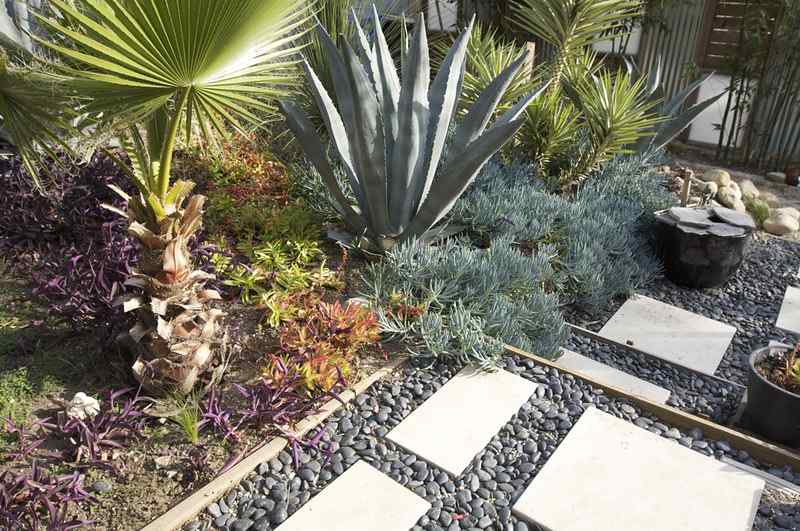
Photo Credit: Jeremy Levine / Flickr / CC BY 2.0
Despite its unusual name, xeriscaping is a trendy new method for landscaping your property in a way that minimizes water usage as much as possible. There are many ways to xeriscape:
- Add hardscapes such as walkways, patios, or retaining walls to your landscape.
- Plant desert plants such as succulents, agaves, or cacti.
- In place of a traditional garden, try a rock garden to add a unique flare to your yard.
- Treat your plant beds to a layer of mulch or organic matter, as this helps your soil retain moisture.
- Replace your lawn grass with a drought-tolerant type of grass.
- Improve irrigation by choosing drip irrigation instead of spray sprinklers.
Don’t worry about xeriscaping making your lawn look boring and bland. No one ever said that a yard can’t be both beautiful and practical. Combining a mixture of colorful drought-tolerant plants, vibrant mulches, and striking rock beds can make the colors of your xeriscape pop.
Not only does xeriscaping hold up in the blistering New Mexico heat, but it is also low maintenance.
Advantages of xeriscaping:
- Conserves water
- Saves you money on water bills
- Low maintenance
- Can improve curb appeal
2. Consider Xeric Plants
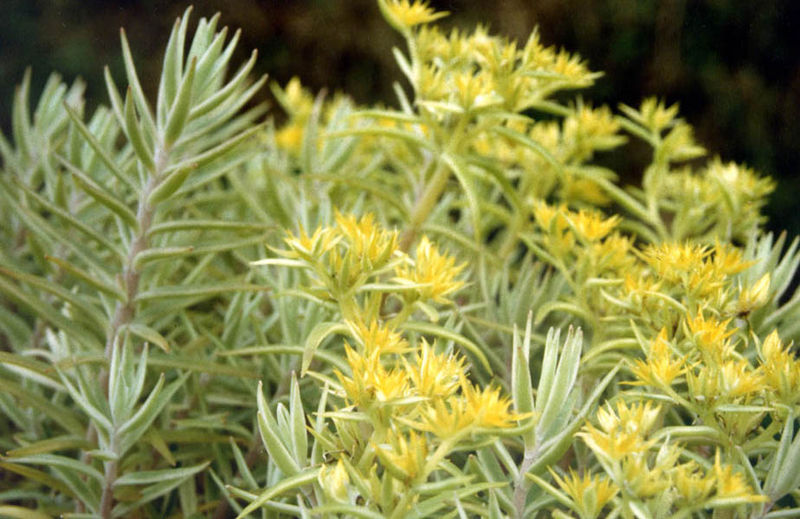
Photo Credit: Ghislain118 / Wikimedia Commons / CC BY-SA 3.0
Some plants are water guzzlers, whereas other plants can go for extended periods without rain or water. Plants that thrive in environments with low moisture and full sun are known as xeric plants.
Luckily, there are many types of drought-tolerant plants to choose from:
- Groundcovers
- Ornamental grasses
- Shrubs
- Succulents
- Trees
- Turfgrasses
- Wildflowers
Here are some specific drought-tolerant plants to help you get started:
- Blanket flower
- Bougainvillea
- Lantana
- Lavender
- Sedum
- Verbena
Even if a drought-tolerant plant withers during a drought, the roots will remain so the plant can grow back next year.
Don’t forget to also think about installing drought-tolerant grass in your yard. Lawn grasses consume a lot of water during the hot season, so it’s a good idea to find a turfgrass that will last in the summer heat.
Here are some types of drought-tolerant grasses that perform well in New Mexico:
Advantages of drought-tolerant plants:
- Conserve water
- Survive droughts
- Low maintenance
3. Go Native with Native Plants
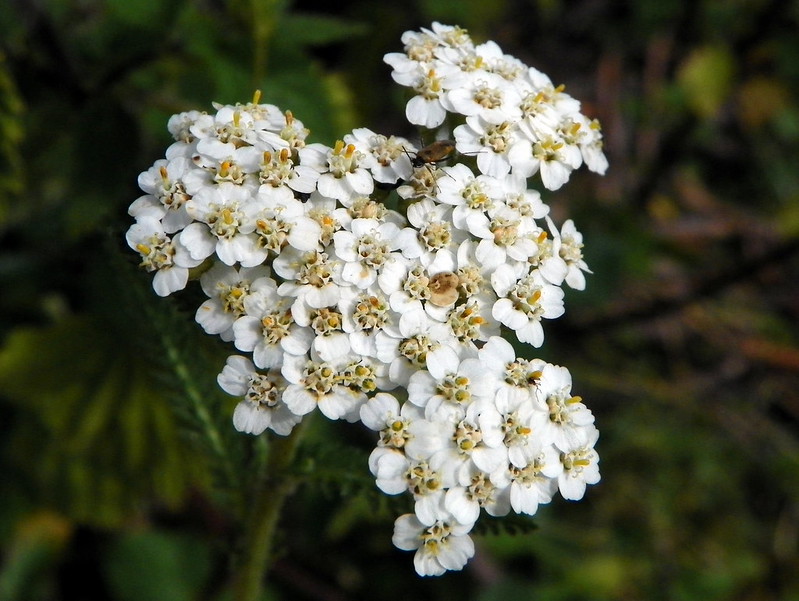
Photo Credit: Peter O’Connor / Flickr / CC BY-SA 2.0
For as dry and hot as New Mexico’s climate is, it will take hardy plants to survive in the desert-like state. Since they grow in the wild without outside help, native plants are drought-tolerant and capable of growing in your yard without much maintenance.
Plant some flowering plants to add a splash of color to your yard and attract pollinators, such as hummingbirds and butterflies, at the same time. Choosing deciduous plants will ensure your plants last longer than annuals, and evergreens are a good choice if you want to keep your yard filled with green foliage year-round.
Before you start adding native plants to your yard, you should determine your soil’s USDA hardiness zone:
- North New Mexico: 5a – 7a
- Central New Mexico: 5b – 7b
- South New Mexico: 7b – 8b
Once you know the hardiness zone for your area, you can research plants that will grow well in the local soil and climate.
Some native plants to choose from include:
- Beardtongue
- Cherry sage salvia
- Desert willow
- Purple poppy mallow
- Rose
- Yarrow
- Yucca
Advantages of growing native plants:
- Resistant to local diseases and insects
- Attract local pollinators
- Encourage biodiversity by providing food and shelter to local wildlife
- Require less water
- Adapted to local soil
4. Spruce Things Up With Artificial Turf
Tired of all the work and stress it takes to maintain your lawn every day, and you just want a break? An alternative is to switch to an artificial grass yard instead. Using artificial turf means having a lawn you don’t have to mow and maintain and stays green year-round.
Artificial turf is designed to mimic grass. It looks so realistic that your neighbors won’t be able to notice a difference between your artificial lawn and live grass. Artificial turf comes in different types and textures, so you can customize your lawn by picking the grass that best matches your home.
Advantages of artificial turf:
- Conserves valuable water resources
- No mowing, fertilizing, or watering
- No need for pesticides
- Conserves water
- Evergreen lawn
- Saves money and time on lawn maintenance
- Pet-friendly
- Lasts 15-20 years
5. Install a Rock Garden
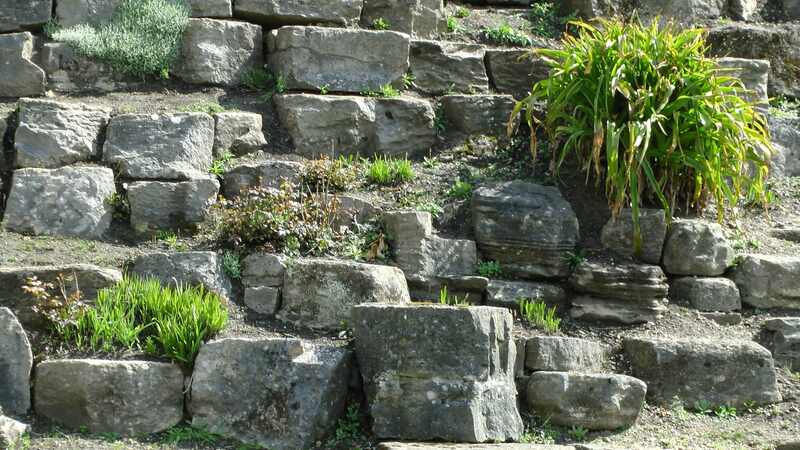
Photo Credit: PublicDomainPictures
When you hear the word garden, most likely you envision images of crisp green leaves, the scent of freshly turned earth, aromatic wildflowers, and colorful butterflies.
But there is another type of garden: a rock garden. While a garden made of rocks may sound drab and bland, it can be quite beautiful and colorful. And if you want more interest and variety, you can add drought-resistant plants like cacti, sedums, and succulents to your rock garden.
After they are installed, rock gardens require virtually no maintenance. They are weed-resistant and save homeowners the trouble of lawn maintenance. You can enjoy the picturesque beauty of a rock garden without putting in all the effort a traditional garden requires.
Advantages of rock gardens:
- Low maintenance – no watering, mowing, fertilizing, weeding, or trimming
- Rock gardens are eco-friendly since they don’t need pesticides
- Conserves water
6. Make a Splash with Drip Irrigation
It may surprise homeowners to learn that sprinkler systems and garden hoses waste a lot of water. Sometimes water spray lands where it’s not supposed to or evaporates before the plants even have a chance to absorb the water.
Forgo using traditional sprinklers and use drip irrigation instead. Drip irrigation waters your plants slowly over time by delivering moisture right to the roots of the plant, drip by drip.
If a drip irrigation system isn’t in your budget right now, you can purchase a soaker hose attachment instead. Position the soaker hose around a tree so it can slowly provide water to the plant’s root system.
Advantages of drip irrigation:
- Reduces water loss
- Efficient deep watering method
- Low water use compared to traditional sprinkler systems
7. Layer On the Mulch
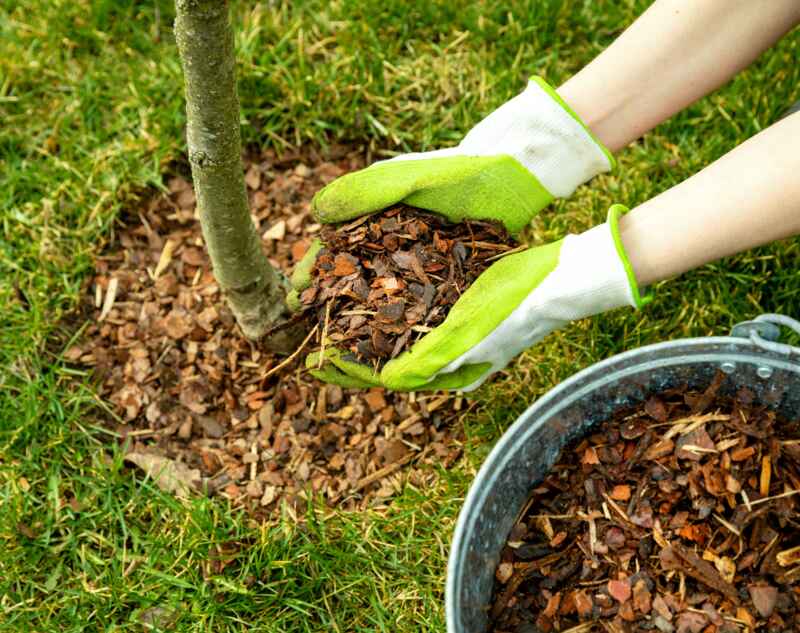
Photo Credit: ronstik / Canva Pro / License
Adding mulch to your landscape is one of the easiest ways to improve your yard while also increasing its drought resistance. Simply purchase a bag of the desired mulch and spread a layer of it over your plant bed.
Mulch traps moisture in the soil and shades plant roots, preventing the soil from drying out. It also prevents weed growth.
Advantages of mulch:
- Promotes healthier soil and plant growth
- Helps the soil retain moisture
- Supplies soil with nutrients
- Protects plants and roots from the sun’s heat
Organic mulches break down as they age and feed nutrients back to the soil. Made from organic materials, they are a good choice since they provide nutrients to the soil:
- Compost
- Grass clippings
- Pine needles
- Rubber
- Shredded bark
- Shredded leaves
- Straw
- Wood chips
The downside of organic mulches is that since they break down over time, they have to be replaced frequently.
If you don’t want to replace your mulch often, consider using an inorganic mulch instead. Here are some examples of commonly used inorganic mulches:
- Gravel or crushed stone
- Rubber mulch
- Landscape fabric
- Plastic mulch
- Landscape rocks
However, you should avoid using rocks for mulch. While they look nice, rocks dry the soil out and don’t retain water as well as organic mulches do.
8. Downsize Your Lawn With Hardscapes
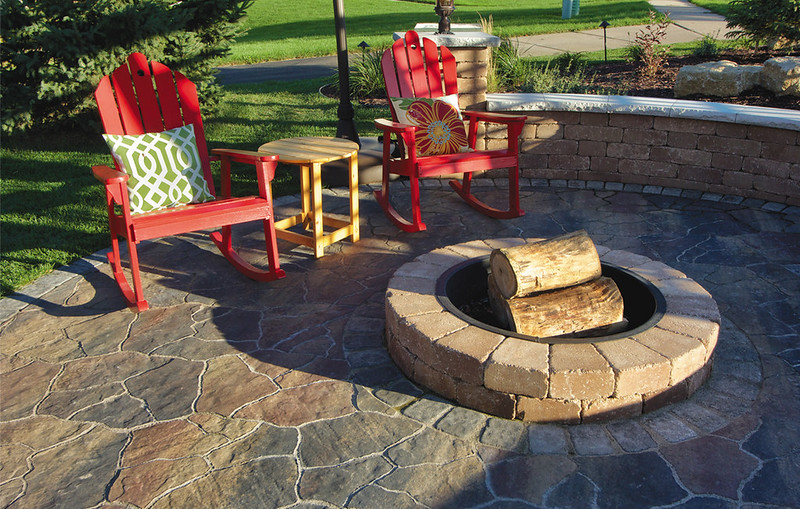
Photo Credit: Rochester Concrete / Flickr / CC BY 2.0
Overwhelmed by the massive amount of lawn care that your grass requires? Try downsizing the green space in your yard by adding hardscapes to your property. Not only will they increase your home value and improve curb appeal, but they also require little maintenance aside from the occasional cleaning. And most hardscapes even serve recreational purposes.
Here are some hardscapes you might consider adding to your yard:
- Decorative rocks
- Rock gardens
- Stone pavers
- Garden walkways
- Pergolas
- Patios
- Decks
- Fire pits or fireplaces
- Retaining wall
Advantages of Hardscapes:
- Less mowing, watering, fertilizing, and applying pesticides
- Conserves valuable water resources
- Improves curb appeal
- Increases home value
9. Go Mobile With Container Gardens
Another way to cut back on excessive water usage is to trade your traditional flower bed for a container garden. Keeping your plants in containers and pots makes them easier to water and take care of.
Advantages of container gardens:
- Easy to take care of
- Potted plants can easily be moved indoors during extreme weather
- Good for people with limited mobility
When selecting containers for your potted garden, keep in mind that bigger pots store more moisture. And since these containers are mobile, you can carry them indoors during extreme temperatures. Storing them inside during the worst parts of a drought can prevent them from getting scorched by the sun.
10. Use a Rain Barrel
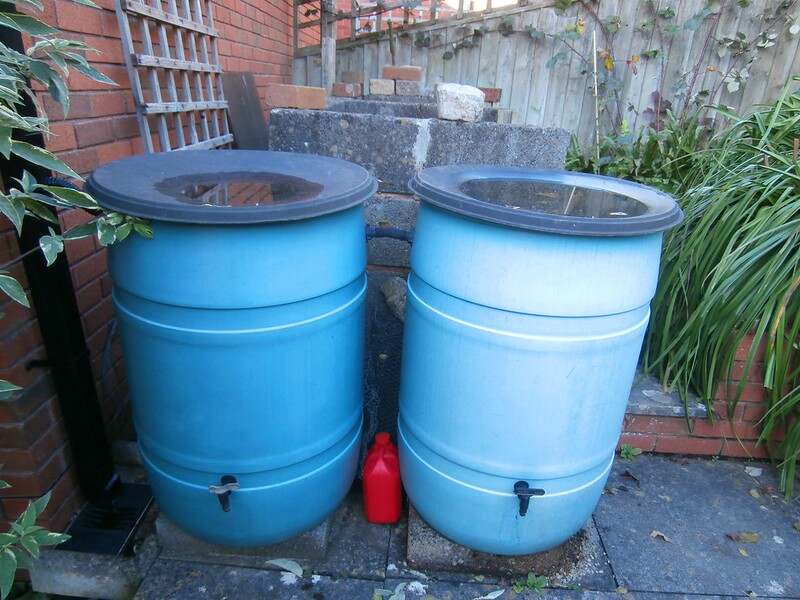
Photo Credit: Jennifer C. / Flickr / CC BY 2.0
Rain barrels help reduce water waste by repurposing rainfall. Install a rain barrel as a part of your gutter system so you can harvest rainwater and save it for when you need to water your lawn.
Advantages of rain barrels:
- Conserves water
- Saves money on water bills
- Reduces stormwater runoff
For every 1 square foot of your roof, 1 inch of rainfall fills your rain barrel with an average of 0.6 gallons of water. And if you don’t want the rain barrel to be an eyesore in your yard, you can do the following to hide or disguise it:
- Surround it with tall, decorative plants or trellis covered in climbing vines.
- Use a decorative garden screen or lattice panel to enclose the rain barrel.
- Build a wooden enclosure or box around the rain barrel using materials that match your garden aesthetics.
- Use decorative covers or wraps designed to conceal rain barrels. These covers often mimic the appearance of natural materials like rocks, terracotta, or wood.
- Incorporate it into an existing garden feature, such as a fountain, planter, or sculpture.
- Apply paint or decorative designs to the exterior of the rain barrel to match your garden theme. You can use stencils, mosaic tiles, or even commissioned artwork to turn the rain barrel into an artistic piece that complements your landscape.
11. Hydrozone Your Plants
Hydrozoning is the art of arranging your landscape plants in a way that they’re grouped together depending on their water requirements. This way, plants with the same water needs can be easily watered, helping save time and reducing water loss.
Advantages of hydrozoning:
- Water-efficient
- Low maintenance
- Saves money on water bills
FAQ About Drought-Resistant Landscaping for New Mexico
Conserving water becomes even more crucial during a drought. Generally, you should water your lawn less often but deeply to encourage roots to grow deeper. You can choose any of these options:
• Let your lawn go dormant. A dormant lawn requires 0.5 inches of water every two weeks. It’s enough to help your grass survive the drought but will not keep it green.
• Keep your lawn green. If you choose to keep your lawn green throughout the drought, it will take a lot of water. Most turfgrasses need 1 inch of water every week.
Additionally, you can consider using drip irrigation to deliver water directly to the roots, minimizing water loss through evaporation.
Water in the early morning before 10 a.m., preferably between 4 and 6 a.m. Never water in the afternoon or during the hottest times of the day.
If watering in the morning isn’t an option, water your lawn in the evening between 6 and 8 p.m. Don’t wait until it’s too late at night. You don’t want water to sit in your yard overnight since a damp lawn can attract lawn diseases and pests.
Don’t fertilize your lawn during a drought. Fertilizers should never be applied when the grass is dormant.
If New Mexico is experiencing a drought, cut your grass longer and mow less frequently – but don’t stop mowing altogether. During this time, never cut more than ⅓ of the grass’s height. Otherwise, it can damage your grass.
Professional Help for Your Drought-Resistant New Mexico Landscape
There are many ways to turn your yard into a drought-resistant landscape. It can be as simple as adding a layer of mulch to your flower bed or as extensive as installing a rock garden in your backyard. No matter how small, any step taken to reduce your yard’s water consumption makes it more capable of taking care of itself and less likely to succumb to droughts.
Looking for a New Mexico lawn care pro near you? We have trusted lawn care pros in Albuquerque and many more cities across the Land of Enchantment.
Main Image Credit: Coralles, New Mexico / ivanastar / Canva Pro / License